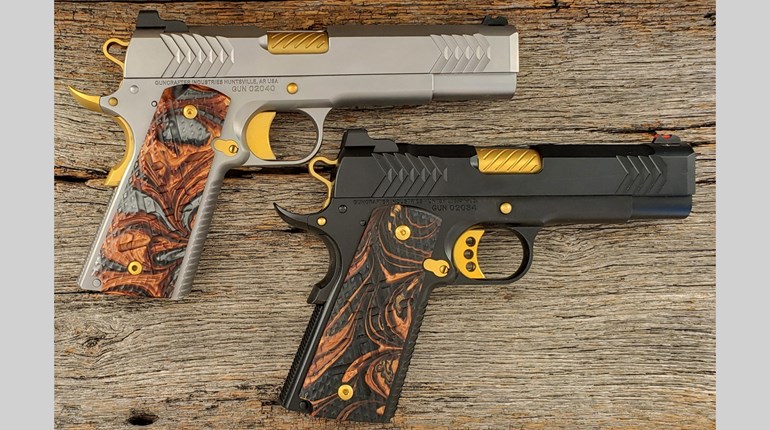
The first development came in the late 70s as Bar-Sto Precision Machine owner, Irv Stone, Jr., and some shooting buddies began to look at why the .38 Super lacked the accuracy so many other cartridges enjoyed. They found the single difference between a .38 Super and a .45 ACP in a 1911 was the Super headspaced on the small (often inconsistent) semi-rim on the narrow barrel hood rather than on the case mouth, like the .45. Stone began working on new barrels, which would allow the super to headspace on its case mouth. Like magic, the constant headspacing lead to tremendous improvements in accuracy. Stone's work at Bar-Sto would become the industry standard for barrels within a few short years.

The original Colt Super .38 and the upgraded Colt Super Match also had a feed system, which caused the tip of the bullet to ride down a bevel in the frame, across a gap, to a bevel in the chamber. This slight gap or setforward of 25 or 30 thousandths between the rear edge of the chamber bevel and the front edge of the frame bevel was extremely important, as the barrel may not completely contact the frame during loading. In a pistol with some play between the barrel and frame and no setforward, the sharp edge of the chamber bevel could, and often would, catch a hollow point and jam the gun. As the bevel was moved forward into chamber to aid in reliability, a larger portion of the case was left unsupported.
The decrease in support opened up a new can of worms as IPSC shooters ran hotter ammunition to make the major power factor of 165 at the time (calculated by multiplying the bullet weight in grains by the velocity in feet per second and divided by 1,000). Shooters began to experience "Super face," a very violent and dangerous cartridge malfunction, in which the base of a hot load blows out.
Thee second development came in response to the Super face but had been around for years. Jim Clark of Clark Custom Guns, had been building autoloaders with feed ramps integrated into fully supported barrels to fire wadcutter cartridges and began to apply this system to the .38 Super. Bar-Sto picked up on Clark's idea and began to manufacture barrels with feed ramps and fully-supported chambers. Today, there are several types of ramped barrels on the market, including models from Bar-Sto, Clark and Wilson Combat.
In the last few decades, there has been widespread adoption by the IPSC community and NRA Action Pistol shooters of the .38 Super because of a 10-round capacity in a single-stack 1911, ability to meet power factors, accuracy and supreme controllability. The Super and its new and improved counterparts have won an astounding number of national and international championships.

If your racegun isn't chambered in the .38 Super or one of its evolutions, chances are you won't even place in the top 20 percent at the NRA Bianchi Cup Action Pistol Championship. Doug Koenig was the first shooter to ring up a perfect score at the cup. He did it with a revolver in 1990. He discovered the .38 Super/1911 combination in the late 1980s and began using it at Bianchi in 1992. Since then, he has won more Bianchi Cup Championships than anyone else in the sport—17 to be exact.
"We were shooting it in IPSC and the Steel Challenge, so it was a natural to use it in Bianchi," said Koenig. "I really like it and would have no reason to change. It's a super accurate and reliable round. For competition it's definitely my favorite cartridge, and the most versatile cartridge with bullets available from 90- to 170-grains. You can load a 125-grain as hot as a .357 Mag."
In the area of personal protection, the super has its fans as well. Former Shooting Sports USA Editor, Stanton Wormley said, "Although I have great respect for the .45 ACP cartridge, I personally prefer the .38 Super for defensive purposes." He added, "It generates as much muzzle energy as most .45 ACP loads. In my favorite carry gun, a Colt Combat Commander, the Super gives me less recoil, a faster second shot, and 20 percent greater magazine capacity than a .45—all of which could be critical in an attack by multiple assailants."
In a time when factories are getting near-custom results in manufacturing and fitting, the cartridge may be on the move. Companies such as Les Baer, EAA and Colt each manufacture models chambered for the .38 Super. Dozens more companies and gunsmiths produce Open-style raceguns for your shooting pleasure.
Even though handloading is the number one provider of the cartridge, due to the ease of reloading and great component availability, many manufacturers market factory-loaded ammunition. Atlanta Arms, Geco, SIG Sauer and Winchester are among many that manufacture great .38 Super ammo.
The .38 Super may have been the last kid picked for dodgeball, but you can't pick a better cartridge for action shooting.



































